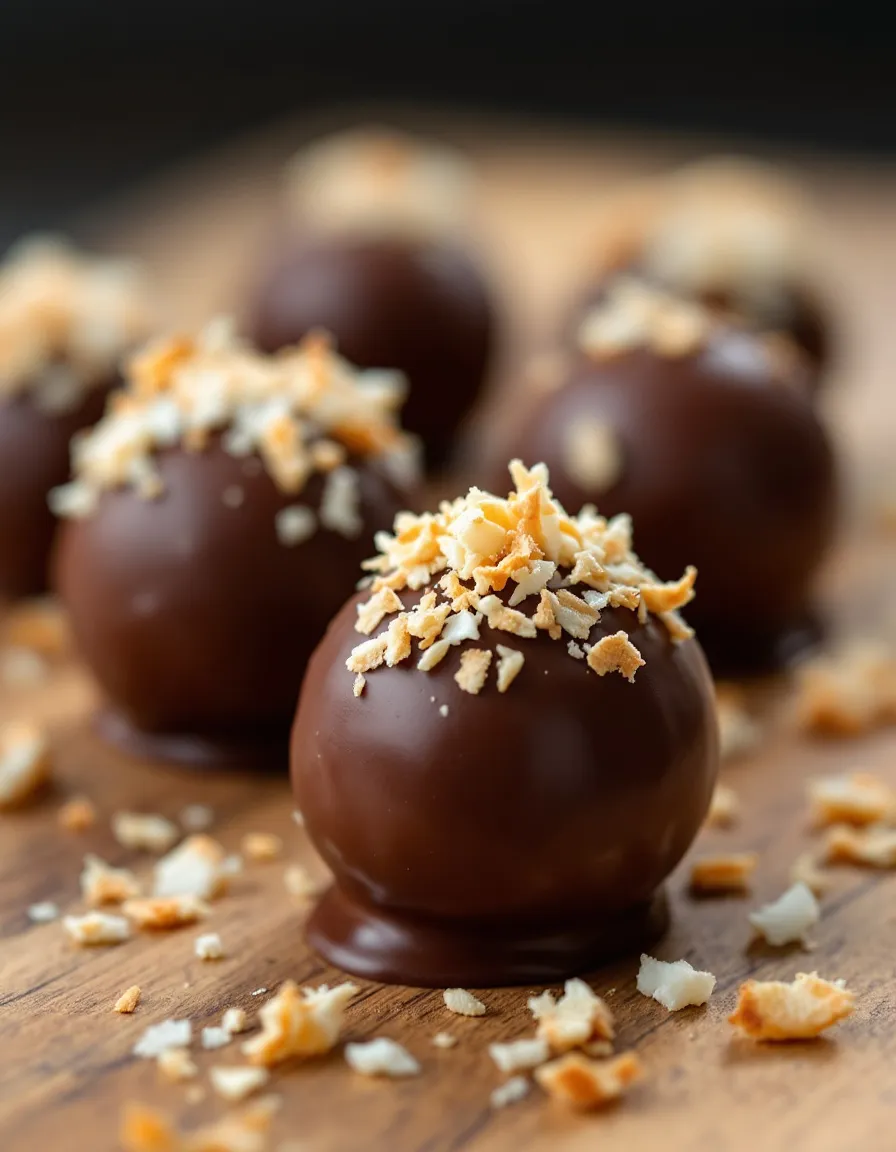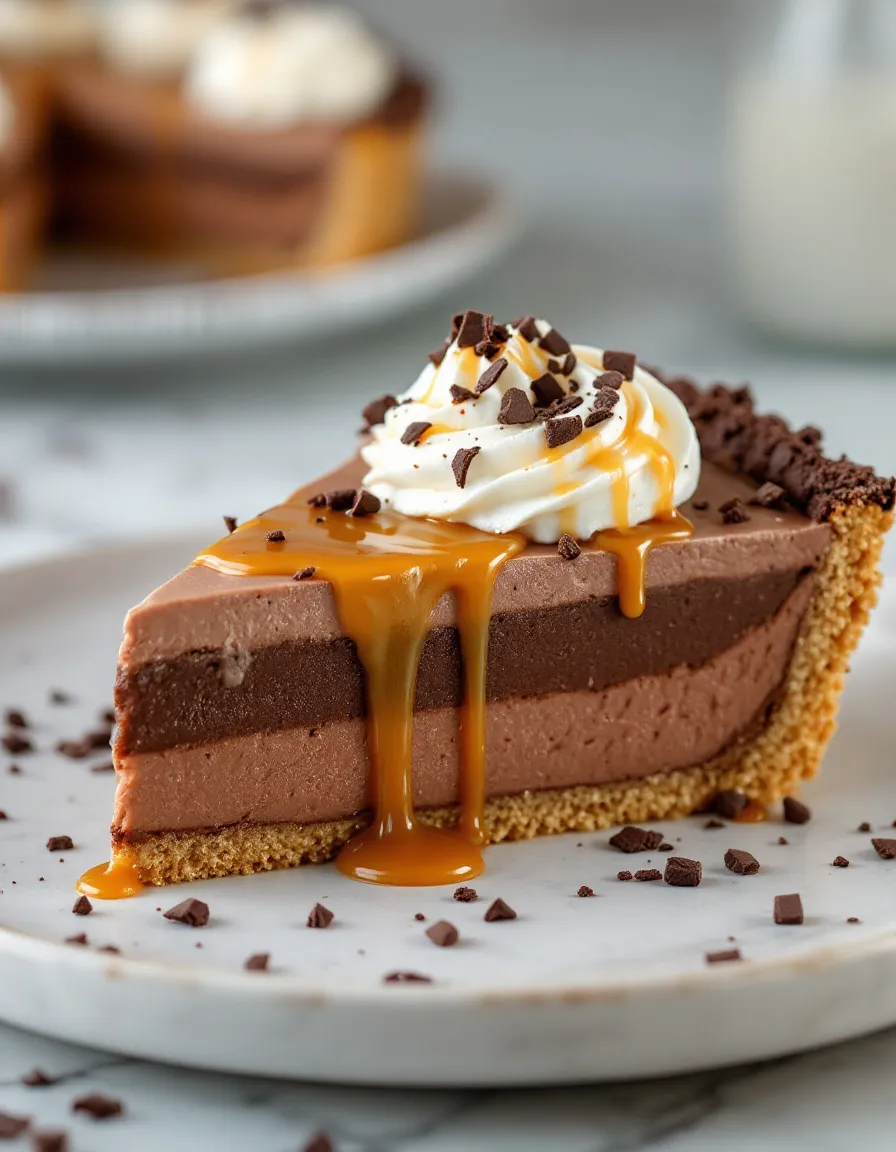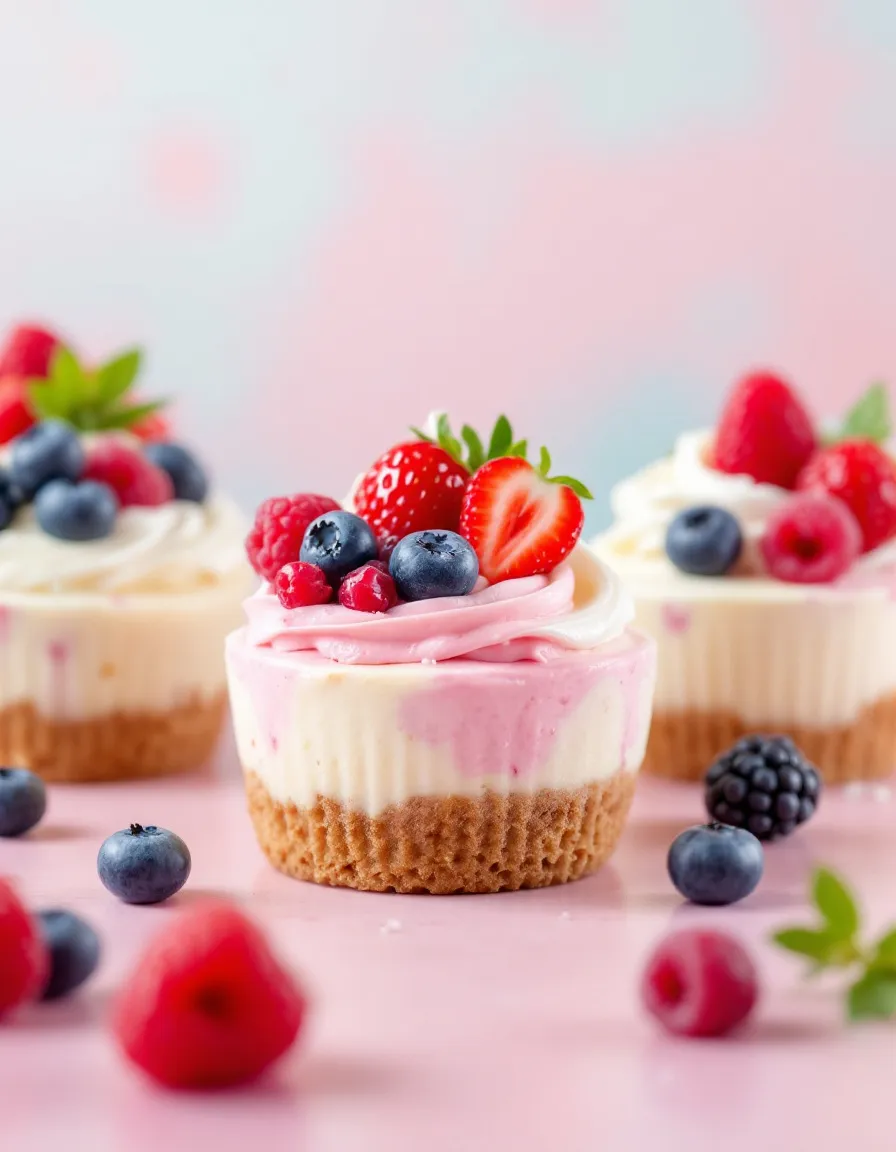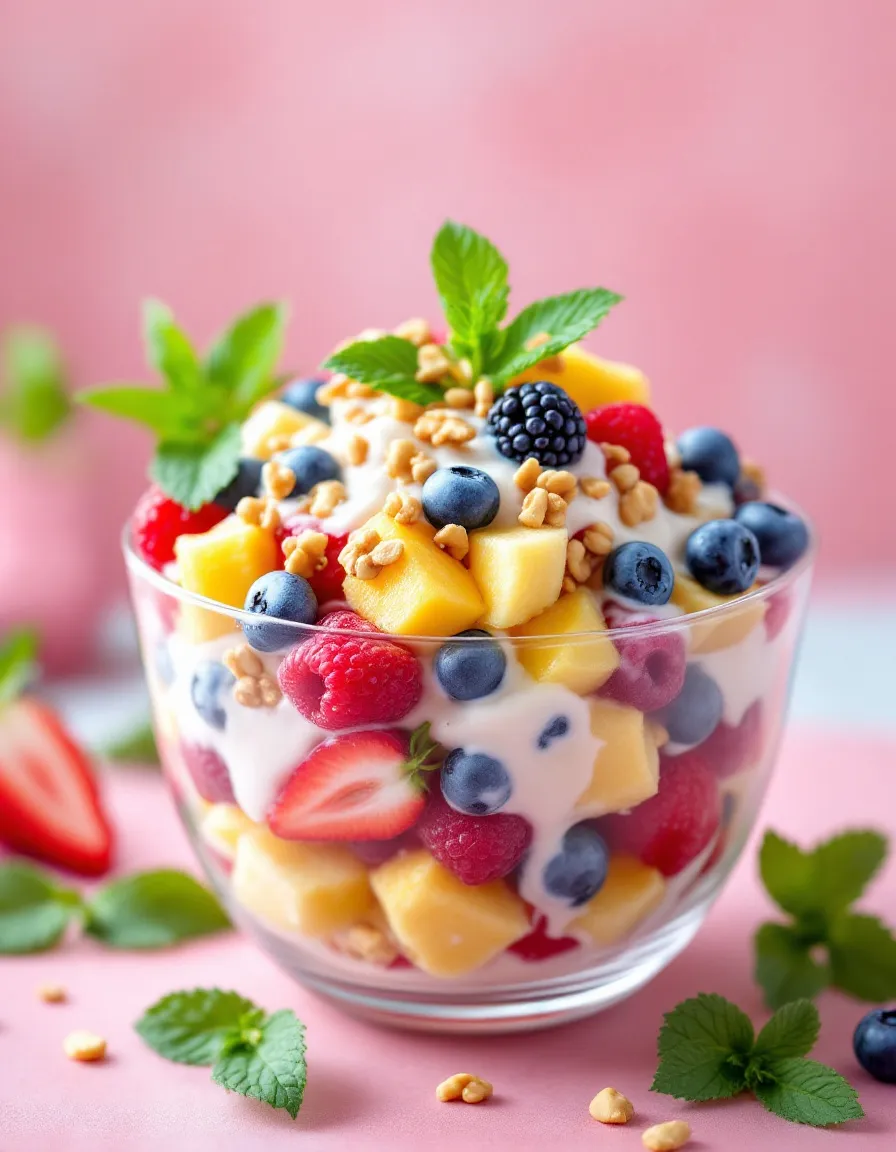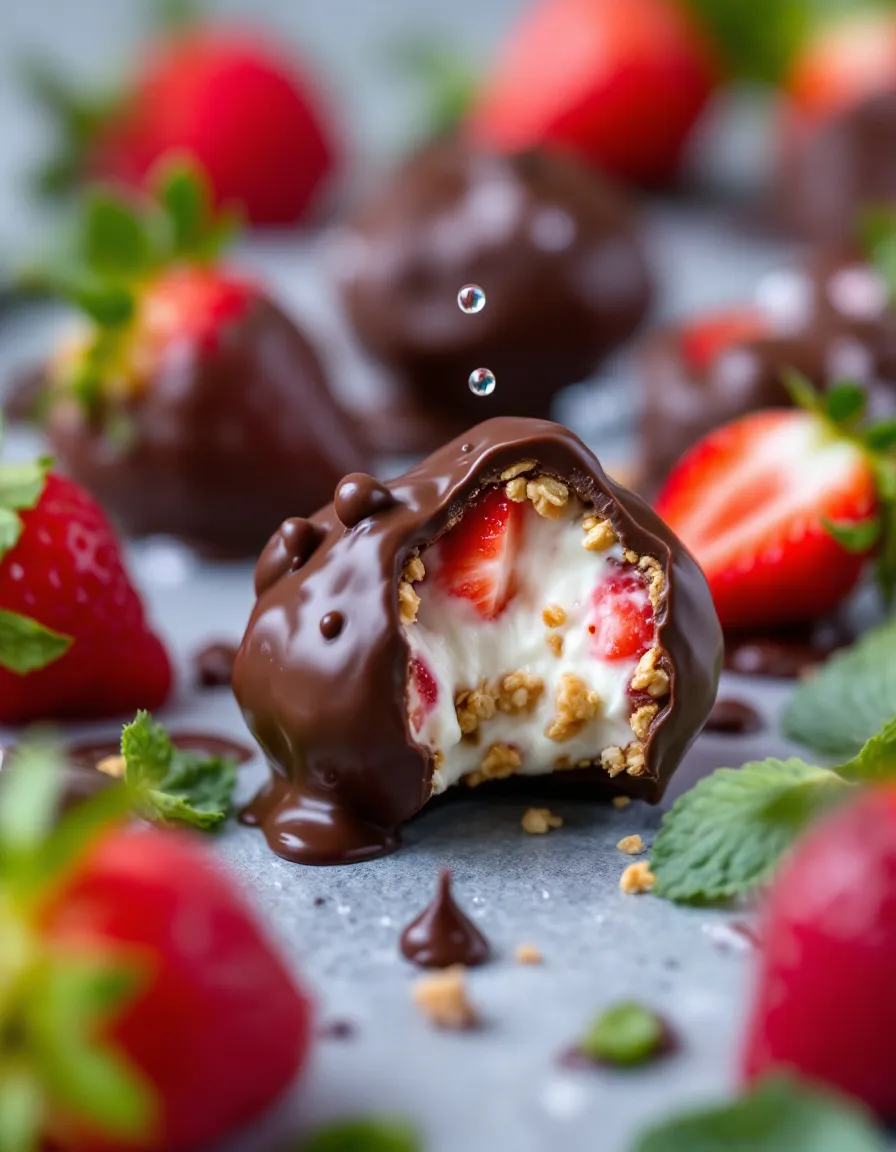Delicious Chocolate Coconut Truffles: A Blissful Treat
Chocolate Coconut Truffles are indulgent little bites that transport you to a tropical paradise with each delicious mouthful. This easy-to-follow recipe combines rich dark chocolate with creamy coconut, creating a harmonious blend of flavors and textures that promises to satisfy any sweet tooth. Imagine the silky smoothness of chocolate melting in your mouth, paired with the delightful chew of shredded coconut—it’s a match made in dessert heaven!
Not only are these truffles a joy to eat, but they are also simple to prepare, making them an ideal choice for both novice and experienced bakers. Perfectly sized for sharing or indulging on your own, these truffles shine at any gathering, from cozy family get-togethers to lavish celebrations. The enchanting aroma of cocoa and coconut wafting through your kitchen will have everyone eagerly anticipating the first bite.
Quick Recipe Highlights
- Flavor Profile: Rich chocolate harmonizes with sweet, nutty coconut for a dreamy treat.
- Texture: Creamy and smooth on the inside with a delightful outer shell.
- Aroma: A tantalizing combination of cocoa and coconut that fills the air.
- Visual Appeal: Glossy chocolate coating with a sprinkle of coconut flakes adds charm.
- Skill Level Needed: Ideal for beginners with straightforward steps.
- Special Equipment: No special tools needed, just basic kitchen items.
Recipe Overview
- Difficulty Level: This recipe is easy enough for anyone to tackle, requiring minimal skill and just a few straightforward steps.
- Category: These truffles fall under the dessert category, perfect for satisfying sweet cravings.
- Cuisine: While they have a delightful tropical twist, these truffles blend influences from various culinary traditions.
- Cost: Ingredients are affordable, making this a budget-friendly treat that impresses.
- Season: Ideal year-round, but especially festive during holidays and celebrations.
- Occasion: Great for gifting, parties, or as a personal treat to enjoy at home.
Why You’ll Love This Recipe
Chocolate Coconut Truffles tantalize your taste buds with their divine combination of flavors and textures. Each bite delivers a comforting blend of rich chocolate and sweet, chewy coconut, making them truly irresistible. These truffles make the perfect dessert for chocolate lovers, transforming ordinary moments into delightful ones. The convenience of this recipe allows you to whip up a batch in no time, ensuring you always have a delicious treat on hand for unexpected guests or sweet cravings.
Not only are these truffles indulgent, but they also carry some nutritional advantages. Made with quality ingredients, you can enjoy them guilt-free. Coconut provides healthy fats and fiber, making each truffle a more balanced treat. When it comes to hosting, these delightful truffles serve as an impressive centerpiece, inviting conversations and sharing among guests. Their cost-effectiveness ensures you can treat your friends and family without breaking the bank, making them accessible for everyone.
In addition, preparing a batch of Chocolate Coconut Truffles opens the door to creativity. You can customize each truffle’s flavor by adding different fillings or experimenting with coatings, such as crushed nuts or colorful sprinkles. This flexibility in presentation and taste keeps the dessert exciting and unique every time you make it. Whether you enjoy them solo or share them, these truffles provide a delightful experience that delights all senses!
Historical Background and Cultural Significance
The roots of chocolate can be traced back to ancient Mesoamerica, where it was revered not just for its flavor, but also for its health benefits and energizing properties. Indigenous cultures like the Aztecs were known to use cacao in their rituals and ceremonies. Meanwhile, coconuts, native to tropical regions, have long been celebrated for their versatility in cooking and health. When combined into tasty desserts like Chocolate Coconut Truffles, they showcase the rich traditions and flavors shared across cultures.
This recipe reflects the evolution of dessert-making, with modern adaptations often reflecting health trends, such as reduced sugar or the inclusion of superfoods. Today, Chocolate Coconut Truffles are enjoyed worldwide, symbolizing indulgence and celebration. Making them at home also allows people to connect with culinary traditions, whether it’s through family recipes or creating their own variations.
While popular in many regions, these truffles can have unique twists based on local ingredients and preferences. For instance, in some cultures, nuts are frequently incorporated within or as an exterior coating, adding additional flavors while enhancing the crunchy texture. Such variations show how these delightful treats adapt and grow with each generational leap, keeping traditions alive.
Ingredient Deep Dive
Chocolate: Cocoa is revered historically for its luxurious qualities and health benefits—rich in antioxidants and, when chosen wisely, dark chocolate can provide numerous health advantages. When selecting chocolate, opt for high-quality brands with a cocoa content of at least 70% for intense flavor. Store dark chocolate in a cool, dry place to maintain its quality and flavor.
Coconut: This versatile ingredient has been an essential part of tropical diets for centuries. Beyond its sweet flavor, coconut is rich in healthy fats and fiber. When purchasing, choose unsweetened shredded coconut to reduce sugar content. Keep it in an airtight container in a cool, dry spot, or freeze it to extend shelf life.
Common Mistakes to Avoid
- Not using quality chocolate: Lower-quality chocolates can affect flavor significantly. Always choose high-quality chocolate for rich taste.
- Inconsistent truffle size: Use a scoop to ensure each truffle is the same size, allowing for uniform cooking and presentation.
- Skipping refrigeration: Failing to chill the truffles can make them difficult to work with. Refrigerate until firm before coating.
- Using fine coconut flakes instead of shredded: This can alter texture. Use shredded, as it gives the truffles a delightful chew.
- Overheating chocolate: This can cause it to seize. Use gentle heat to melt chocolate slowly, stirring continuously.
- Improperly measuring ingredients: Accurate measurements are crucial for balance. Use a kitchen scale when possible.
- Not letting the chocolate set properly: Allow adequate time for the coating to firm up to ensure the best texture.
- Forgetting to allow the truffles to come to room temperature: Cold truffles can taste muted; let them sit at room temperature before serving.
- Being too quick to work with the melted chocolate: Patience is key; let it cool slightly to avoid burning your hands.
- Neglecting flavor additions: Explore extras like spices or flavored extracts to elevate the truffles.
Essential Techniques
Melted Chocolate Mastery: Melting chocolate properly is crucial for achieving that silky texture. Always use a double boiler or microwave to slowly melt chocolate, stirring frequently. This helps maintain the chocolate’s glossy finish and prevents it from seizing. Look for visual cues—a smooth, glossy consistency indicates perfect melting.
Truffle Rolling Technique: When rolling the melted chocolate mixture into balls, ensure your hands are slightly wet to prevent sticking. This technique helps in forming smooth, round truffles. Pay attention to the size consistency for a professional look – smaller sizes are ideal for elegant plating!
Pro Tips for Perfect Chocolate Coconut Truffles
1. Invest in quality ingredients – the flavor of your truffles depends heavily on chocolate and coconut used.
2. Chill the truffle mixture properly before forming to prevent melting during rolling.
3. Experiment with coatings, like nuts or sprinkles, for added texture and flavor.
4. Allow truffles to set at room temperature before serving for the best flavor experience.
5. Don’t skimp on refrigeration time; fully chilled truffles are easier to coat and handle.
6. Try adding a pinch of sea salt to enhance the sweetness and balance the flavors.
7. Use flavored extracts like vanilla or almond for a unique twist.
8. Consider incorporating your favorite liqueurs into the filling for a fun adult version of truffles.
Variations and Adaptations
Chocolate Coconut Truffles provide flexibility to satisfy diverse tastes. For a regional twist, try incorporating local nuts or spices that reflect your culinary landscape. Seasonal adaptations can include pumpkin spice during fall or crushed peppermint during winter holidays. Dietary modifications make these truffles accessible to those with specific needs; consider coconut milk for a vegan option, or use nut-free chocolate if allergies are a concern. For flavor variations, add zests of citrus for brightness or even coffee granules for depth. Texture modifications like adding crunchy graham cracker bits can enhance the mouthfeel, while presentation alternatives like decorating with fresh fruit or serving on elegant platters add an eye-catching element!
Serving and Presentation Guide
The unassuming charm of Chocolate Coconut Truffles often catches attention, yet their presentation can elevate them further. For plating, consider using tiered dessert stands to create an attractive display or contrasting colors on a white plate to make the truffles pop. Garnish with mint leaves for freshness and to invite intrigue. When serving, consider pairing them with a light dessert wine or coffee. With portion control, offer two or three truffles per serving for a lovely balance of indulgence and moderation.
Wine and Beverage Pairing
Pairing beverages with Chocolate Coconut Truffles can enhance the tasting experience significantly. A rich dessert wine like Port or a sweet Moscato complements the dark chocolate beautifully. For non-alcoholic options, consider a sweet chai tea or a rich hot chocolate; both enhance the dessert experience. Temperature is crucial; serve wine chilled and ensure hot beverages are steaming but not scalding to provide a delightful contrast. Presentation, such as serving in elegant glassware, can also add to the overall indulgent feel.
Storage and Shelf Life
To ensure the longevity of your Chocolate Coconut Truffles, store them in an airtight container in the fridge. This helps maintain freshness and flavor. They can typically last up to two weeks when properly stored, but it’s always best to consume them within a week for the best texture. Signs of spoilage include a change in texture or off flavors. Reheating suggestions aren’t necessary; rather, allow them to return to room temperature before serving for optimal taste. If you plan to make ahead, truffles generally freeze well; allow them to thaw overnight in the fridge when ready to enjoy.
Make Ahead Strategies
Making Chocolate Coconut Truffles ahead of time is a wonderful way to save effort on busy occasions. You can prepare the base mixture a day or two in advance and refrigerate it, making rolling and coating easier. However, store them in suitable containers to prevent a dry surface. Quality is essential, so assess the texture after they have been made ahead. When you’re ready to serve, simply allow them to come to room temperature and garnish for a fresh touch. Incorporating fresh elements, like fruits, can also add vibrancy and freshness just before serving, enhancing presentation and taste.
Scaling Instructions
Scaling your Chocolate Coconut Truffles recipe is easy! Halve the ingredients for a smaller batch, or double them for a larger crowd without extensive adjustments to the process. However, if you double the recipe, ensure you have adequate cooling space in your refrigerator, as a larger batch may require longer to set due to increased mass. Adjustment of your mixing bowl size may also be necessary to accommodate bigger batches while preventing any overflow during combining. Timing does not change drastically, but monitor chocolate melting carefully to avoid issues with texture or taste. Finally, consider how you store your truffles post-preparation to maintain quality.
Nutritional Deep Dive
When analyzing the nutritional profile of Chocolate Coconut Truffles, the balance of macronutrients stands out. While they do contain fats from chocolate and coconut, they bring some fiber and antioxidants that can be beneficial in moderation. Specifically, dark chocolate holds flavonoids, which are known to promote heart health when consumed responsibly. Micronutrient analysis also reveals the benefits of coconut, which is high in magnesium and potassium, contributing positively to daily intake. In terms of portion analysis, enjoying one to two truffles can effectively satisfy cravings while keeping within balanced dietary goals, important for managing portion sizes as well.
Dietary Adaptations
Those following specific diets can easily adapt Chocolate Coconut Truffles without losing flavor. For gluten-free needs, offer these truffles as they are since they contain no flour. Additionally, substituting dairy chocolate with dark vegan chocolate ensures a beautiful vegan truffle, while using coconut cream instead of heavy cream can maintain deliciousness. A low-carb or keto audience can enjoy these truffles by utilizing sugar-free chocolate; they can stay satisfying without excess carbs. If needed, modifications for paleo and low-FODMAP diets can also be easily achieved by carefully selecting ingredient brands and checking for sugar content, allowing diverse followers to enjoy these truffles!
Troubleshooting Guide
If your Chocolate Coconut Truffles seem too soft or difficult to roll, chilling the mixture further may help with cohesiveness. For flavor balance issues, consider adding more coconut or adjusting sugar for extra sweetness. If you face melting during chocolate coating, chill the truffles beforehand and work with cooler chocolate to prevent them from becoming too difficult to handle. Equipment challenges like lacking a double boiler can be solved by using a microwave on low power. In the case of ingredient substitutions affecting final texture, be prepared to experiment with ratios to maintain the ideal consistency, always checking with visual cues.
Recipe Success Stories
Thousands of home bakers have delighted in trying their hand at making these Chocolate Coconut Truffles, sharing stories of success. One community reader reports their entire family fell in love upon first bite, leading to quick requests for more! Various adaptations, such as adding espresso powder, have led to unique tastes that have impressed dinner guests. Many have also documented their variations on social media, showcasing stunning photography that captures the tempting charm of these truffles. With tips shared through reviews, novice bakers are often encouraged to make these truffles their own while celebrating the community’s rich culinary explorations.
Frequently Asked Questions
Q: Can I use milk chocolate instead of dark?
A: Yes! However, keep in mind that milk chocolate will make the truffles sweeter and less intense, so adjust sugar levels accordingly.
Q: How can I add flavor variations to the truffles?
A: Consider adding flavored extracts like vanilla or almond. You could also try incorporating zests from citrus fruits for a refreshing twist!
Q: Are these truffles suitable for vegan diets?
A: Absolutely! Use vegan chocolate and coconut cream or other dairy-free ingredients to ensure they fit a vegan diet.
Q: How do I prevent the chocolate from seizing?
A: Melt chocolate slowly in a double boiler or micro-heat at low powers. It’s best to avoid moisture contact with chocolate during melting.
Q: Can I freeze the truffles?
A: Yes, these truffles freeze well! Store them in an airtight container and they can last up to three months in the freezer.
Q: How long do the truffles last in the fridge?
A: When stored in an airtight container, the truffles can last up to two weeks in the refrigerator; however, they are best enjoyed within the first week.
Q: What should I do if my truffles are too soft?
A: If your truffles are overly soft, chill them for longer or incorporate a bit more coconut to achieve the right texture.
Q: What type of coconut should I use?
A: Use unsweetened shredded coconut for the best results; it adds natural sweetness without overly sweetening your truffles.
Q: Can I add alcohol to my truffles?
A: Yes! Adding a splash of liqueur like coconut rum or chocolate liqueur can enhance flavor—just be mindful of the overall moisture content.
Q: How do I get the chocolate coating shiny?
A: To achieve a shiny coating, ensure to melt chocolate slowly and avoid any water contact during the melting process.
Additional Resources
For those looking to explore similar recipes, consider checking out peanut butter truffles, matcha truffles, or even fruit-infused chocolate bites. Each offers a unique twist on the classic truffle, ensuring a delightful exploration of flavors. To elevate your dessert-making skills further, invest time in learning about proper melting techniques and chocolate tempering. Additionally, consider essential kitchen tools like quality non-stick baking sheets and silicone molds, which assist greatly in the process. Seasonal variations can also be helpful; think about recipes that complement or play off the seasons, ensuring fresh and enjoyable treats!
Join the Conversation
We would love to hear your thoughts on your experience making these Chocolate Coconut Truffles! Sharing your beautiful truffle photos on social media helps inspire others and invites delightful comments from the community. Consider offering recipe reviews and adjustments based on your personal touch, as we believe every contribution brings something unique. Engage with fellow bakers about your variations, ingredients, and techniques. Let’s spread the joy of baking and indulge in chocolate together!
The Recipe
Chocolate Coconut Truffles
Serves: 12 truffles
Prep Time: 20 mins
Cook Time: 10 mins
Total Time: 30 mins
Kitchen Equipment Needed
- Mixing bowl
- Double boiler or microwave
- Sheet pan
- Parchment paper
- Measuring cups and spoons
- Cooling rack
Ingredients
- 1 cup dark chocolate chips
- 1/2 cup shredded coconut, unsweetened
- 1/4 cup coconut cream
- 2 tablespoons honey or maple syrup
- 1 teaspoon vanilla extract
- Extra shredded coconut for coating
Directions
- Melt the dark chocolate chips in a double boiler or microwave, stirring until smooth.
- In a mixing bowl, combine melted chocolate, shredded coconut, coconut cream, honey (or syrup), and vanilla extract until mixed well.
- Chill the mixture in the refrigerator for about 15 minutes until firm.
- Once firm, scoop out small portions and roll them into balls.
- Roll the truffle balls in the extra shredded coconut until fully coated.
- Place the coated truffles on a lined sheet pan and refrigerate for at least one hour to set.
- Serve cold or at room temperature, enjoy!
Recipe Notes
- Feel free to use milk chocolate, but adjust the sweetness accordingly!
- Experiment with different flavorings, like coconut rum or espresso powder, for a twist.
- Store in an airtight container in the fridge for up to two weeks or freeze for up to three months.
